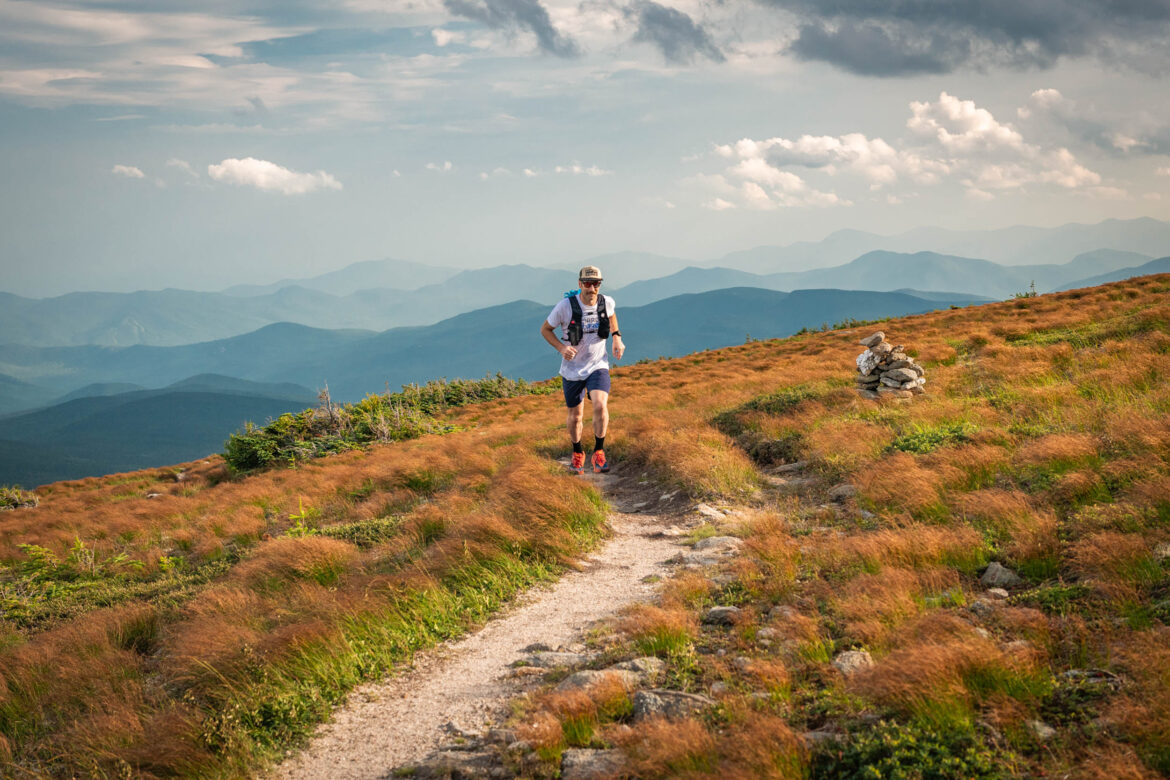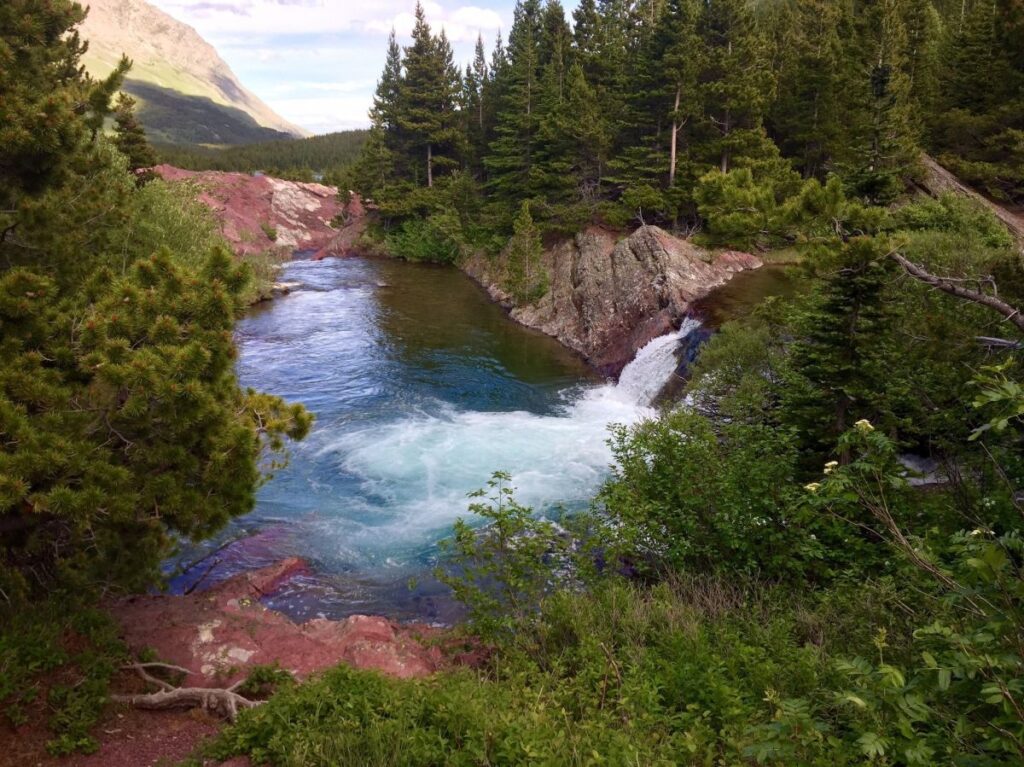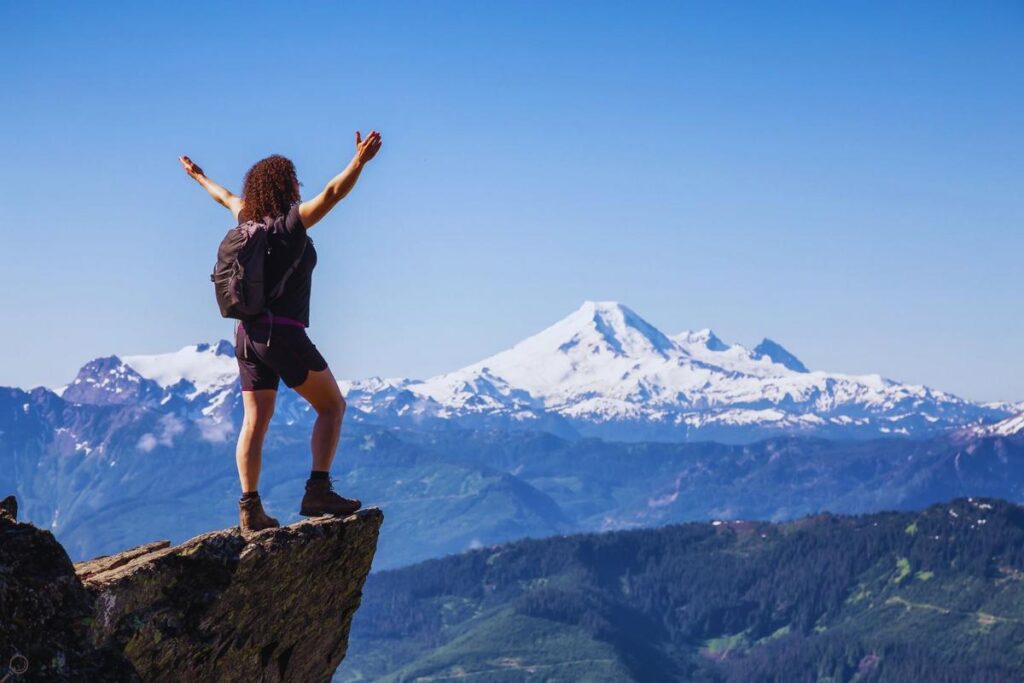By PAULA TRACY, InDepthNH.org
JACKSON – Andrew Drummond, 44, of Jackson just established the fastest known time for climbing all 48 of the state’s 4,000 foot mountains in a single hike, unassisted.
The Mount Washington Valley native, owner of the backcountry gear company White Mountain Ski Co., and endurance runner completed this hike of 231 miles in 4 days, 22 hours and 43 minutes, blowing away the previous record of 5 days, 13 hours and five minutes by more than 14 hours.
The former known record was held by Will Peterson.
He did this in mid July, in the heat, running the ridges and deep dark woods at night.
The “project” as he described it is known as the “White Mountain Direttissima,” which roughly means “direct route” in Italian.
It is considered the most ambitious of hike projects established in the White Mountains.
Drummond also holds the fastest known time for self-powered Direttissima in 2016 when he had friends and his dog, “Squall” join him for portions of the project and where he also had a cache of batteries.
This time, no help, no friends, no cache. Just a drop off and a pick up after a few grueling days in the woods.
Drummond finished that previous effort in just under 6 days when he was nine years younger.
He wrote on Facebook that he did not think he would find the motivation again to return to the route.
But last year, he tried, and bailed out “barely making it half way and limped off realizing I lacked the proper training to even have a shot at the route.”
This year, he said he focused 12 weeks of training and that some relatively good weather and a bit of luck through some of the gnarliest parts paid off.
Last week, he spoke with InDepthNH.org about his journey. He said he is recovering after losing eight pounds, and is getting back to life at home and catching up with folks around the country eager to hear about the accomplishment.
He said he will do other “hard stuff” but is pretty sure he is satisfied with this accomplishment and not planning on a third run at it.
“Nothing came easy. I dealt with massive fatigue, sleep deprivation, blistered feet and screaming knees.
“I fell out of love with this route many times, especially at the end when I felt like I was stuck in the purgatory known as the Kilkenny Ridge Trail, navigating of blowdowns under a dying headlamp and a red moon on the horizon,” he wrote.
Thankfully, in the parking lot at the Mount Cabot trailhead at 3:31 a.m. July 13 it was over and a new fastest known record was established.
Above, Andrew Drummond atop the Northeast highest Peak, Mount Washington during his record setting through hike of all 48, 4,000 foot mountain in NH in July. CHRIS BENNETT photo
According to Philip Werner, author of “Hiking Over 60: A Modern Guide to Hiking Gear and Techniques for Active Adults and Backpacking the White Mountain 4000 Footers,” “the Whites” have their share of difficult hiking lists and challenging hikes.
“The White Mountain 4000 footer list with its 48 peaks, is the list that most aspiring New England hikers cut their teeth on,” he wrote. “For those seeking a more extreme challenge, there’s The Presidential Traverse, The Pemigewasset (Pemi) Loop, and The Grid, which requires hiking all 48 of the White Mountain 4000 footers in each month of the year.
“But the hardest and most extreme hike in the White Mountains is called the White Mountains Direttissima which requires hiking all 48 of the White Mountain 4000 footers in one continuous route.
“The first White Mountains Direttissima was completed in 1970 by Henry Folsom over the 46 White Mountain 4000 Footers (there were two fewer peaks on the list then) where he climbed all of the peaks and walked the distances between them but drove home each night to sleep in his own bed,” he said.
Werner went on to say: “There is no governing organization but a few rules. There’s no set route. You can follow hiking trails, snowmobile trails, XC ski trails, roads, or hike segments off-trail if you wish. You can hike it unsupported, by carrying all of your food the entire distance, or supported by others, including visits to restaurants, food shops, or lodging along your route and fastest known times are categories either as assisted or unassisted.
“You can hike it continuously or break it into smaller sections, drive home to rest, and resume where you left off previously. “The only hard and fast rules are that you walk, run, and/or ski the route end-to-end and start at a trailhead and finish at one.
“Since 2007, a dozen or more hikers have completed the White Mountains Direttissima, and it’s attracted its fair share of people wanting to set supported and unsupported FKTs (Fastest Known Times).”
Drummond said he has been reflecting on the experience and the accomplishment and hopes that it will inspire and spur others to go out there and beat his record which he said would be “gratifying.”
He said he picked July as a time to attempt it knowing that the days would be some of the longest of the year making navigating technical trails with a couple of extra hours of daylight.
Drummond said he also looked at whether there would be rain at night before leaving.
Though rain can be beneficial and cooling while hiking, it is difficult at night while attempting an hour or two of sleep. In those cases, he would soldier on instead of taking rest in the wet.
“You want to have a weather window that allows you to do the project. You can’t have extreme heat, extreme cold, extreme rain, any of those can end your project pretty quick,” Drummond said.
Though he said he had a Garmin Inreach device that could tell him the weather (and alert to an emergency) he did not really look at it.
“I didn’t really need it too much. It honestly didn’t matter. The weather wasn’t going to change a whole lot,” due to the spatial variability of the local weather in the Whites, he said.
“Rain is almost inevitable, but the goal is not to have it rain at night,” he said his goal was to sleep four or five hours a night.
“You never feel well rested. Because you don’t sleep well at night going into it…because you are anxious,” he said and then when on the trail “you are aching which makes it hard to get comfortable to rest.
“Ultimately if you can sleep a few hours a night then you are in good shape to keep going. But it wasn’t really until, even the second day I had to take a power nap a few hours into the morning just because I felt so tired, and then that usually would get me through the rest of the day. Then the last day, I had to take two little mini naps or lay downs that were not more than five minutes each or so and that got me through the last 24 hours.”
He said packing light and considering food intake needs are “everything. It means a lot. So I tried to get my base weight – which is my pack weight without food or water – below eight or nine pounds and then by food weight I just rationed off about a little over two pounds per day,” he said.
He used ZipLock gallon bags full of chips, Cheez Its, Snickers bars, Swedish fish, and powdered drink mix.
“Knowing how long you are out there and (how) much you will need each day is so individualized,” he said. But experience on this trip nine years before helped him pack.
Still, he said he lost about five percent of his body weight during the trek.
“Sometimes it was so hot,” he said that he did not want to eat.
Drummond said he was dropped off at the base of Mount Moosilauke near Lost River Gorge and decided on a south to north route ending in the Kilkenny Range.
He said he went south to north by choice and broke it up, almost like a stage race where each day he knew where he wanted to get by nightfall.
“And I had a little Plan B, if I could go a little farther, but honestly that original plan worked out and it was…and I didn’t have to take the risk of pushing it further….last year I tried and I ended up with anterior tibialis tendonitis….my ankles swelled up and I had to stop. So I knew…that would be a concern and I didn’t want to push it.”
He recalled the days and mountains.
“Day one was Moosilauke to the base of Owl’s Head and so you get to cover the Kinsmans…Franconia Ridge and I chose a route that sent me over Garfield and had me down to the Thirteen Falls area.
“That set me up for the next day,” where he went up Owl’s Head, bushwhacked up the north side and came back down and finished off the Pemi Loop, continuing up to Galehead, the Twins and Zealand and the Bonds “and that sent me back towards the Kanc to go do the Hancocks and over and finish with the Osceolas for that night,” where he spent the night off Tripoli Road.
“I was feeling pretty, pretty exhausted but none of the tendon stuff was acting up,” he said.
Day three he went from Tecumseh over the Tripyramids, Whiteface, Passaconaway, all the way across to Carrigain, down to Shoal Pond and up to Zealand Notch.
“So that was a great day. A cool off. It rained for the middle of it and it was refreshing and cool and I was able to eat a lot more and I was able to move really well. I was just excited to pass the spot where I bailed last summer. And the weather cleared up. I did get some foot pain and tendon pain in Zealand Notch and had some blisters, but I had plenty of time that night to reset and regroup for the next day,” Drummond said.
Day 4 was a big one.
It included going from Zealand all the way to Hale, over to the Willy Range and then the Southern Presidential Range to Mount Washington and then to Isolation back up and then down Route 16 via Glen Boulder.
“I decided it was close to sunset and the Wildcat Ridge trail that the AT (Appalachian Trail) goes up is really steep and demanding and I just kind of took an alternative route and walked Route 16 over to the ski area and took the ski trail PoleCat up (at Wildcat).”
“It was like a deal with myself to get that vertical but the easiest, passive, you know path of least resistance, and it actually worked out really nicely because I didn’t need a headlamp. I was on an open trail. It was kind of a beautiful sunset and the fireflies came out and it sort of distracted me from how hard Wildcat historically is on that route. Most people opt to go up the Ridge Trail. That’s what I did in 2016 and it just took way longer, way more technical” he said.
Drummond said he rested for a while on top of Wildcat in his bivy sack and even slept in a bit and woke up at 3:30 a.m. but did not get going until 4:30 a.m.
The last day was also big in many ways, he said.

Above, the route Andrew Drummond took to accomplish the fastest known time for a hike of all 48 4,000 footers known as the Direttissima.
“I don’t think I realized how difficult a day it was going to be. Originally it was supposed to be like 54 miles but that was when I was planning to make it all the way to Carter Notch…But since I didn’t, it ended up being more like 60 miles and you do a whole Wildcat-Carter-Moriah Range and you dip back down to Route 16 and then you head up the Northern Presidentials. So you go up Madison over to Adams, Jefferson and Jefferson Notch Road which turned out to be about 12 miles to get to the next trailhead and so you are combining the dirt road with, up on Route 2 it becomes a paved road…It rained pretty hard on me on Mount Adams but then it cleared off once I got over to the West side down Jefferson and you know running down Jefferson Notch Road, I definitely got more blisters but I was just trying to make time. I was trying to run as much as I could and you can see the last range in the distance once you get on Route 2,” he said.
The range connects Mount Waumbeck and Mount Cabot and it is a really long section.
“It is pretty daunting. But again, I am looking at the short term goals,” he said. He said he focused on getting to the trailhead and then getting from the trailhead to the Starr King summit. Then get as far without using the headlamp.
“And then you realize ‘now, okay, I need to make this next section and it is probably some of the hardest trail on the whole route to get under five days.’
“So I was racing the clock to get through the really challenging trail of ferns and blowdowns and you just can’t see your feet. You can’t move fast. It’s at night. You’re exhausted. All my electronics at that point were dying so I had to conserve batteries. So you are in your own head and you are trying to just keep making forward progress.
“I started to get a little out of it – my decision making wasn’t great – when I got to the junction with the Cabot Trail. I had lost my bearings and spent several minutes trying to figure out where I was. Ultimately, I dropped my pack and ran up with a headlamp and a water bottle and realized that my headlamp was probably going to die so I had to go faster and take a little more risk there and lucky I got to the summit of Cabot with the headlamp. Then from there you really smell the barn and you really have to get down to the trailhead which is still, it’s really like four miles at least,” Drummond said.
“I probably made some poor decisions around then about navigation. I didn’t do enough recon(aisance),” he said.
He said he had not been on the trail in nine years and had forgotten a lot “and it is really technical, slow and frustrating and that puts you in a tough place. But ultimately I knew it would be over. I had to keep going.
“So yeah, I got to the York Pond trailhead at like 3:31 a.m. That was the finish.”
There he met his partner Hilary McCloy and co-worker Spencer Ralston at the trailhead, “and it was amazing.”
“A big project like this. To finish it. To hit your goal. And something that means so much to me growing up here and pursuing endurance sports and picking a project like this and having success and sharing it with people after the fact was pretty special,” he said.
Drummond said his favorite part of the project was in the middle when the rain fell, he cooled down, was traveling well, felt well and he traveled 45 miles from Tecumseh to Zealand Notch and only saw one other person.
“You really don’t get that sort of wilderness experience even on a project like this…That’s what I love about the Whites, it really spreads people out,” he said.
He said he benefited from past experience and knowledge about his body, his training, his gear and what were his limits.
“I knew I could go faster. But it is one thing to say you can, but on a project like this so many things can go wrong,” Drummond said. “I was surprised that people still care about this route…that the reaction from the community was as big as it was. Because I felt like in 2016, I really tried to promote this route and then nothing happened…in the sense that…not many got on it or completed it. I felt ‘well, no one really probably cares about this but I still care about it.’ So this one was probably for me.
“But it was really fun to see how many people did care about it and the reaction was so positive and hopefully…people will get on it because it is one of those life changing experiences because it is so big. It’s so hard that it makes it even that much more rewarding when you get to finish it,” Drummond said.
Discover more from Gear Up!
Subscribe to get the latest posts sent to your email.




